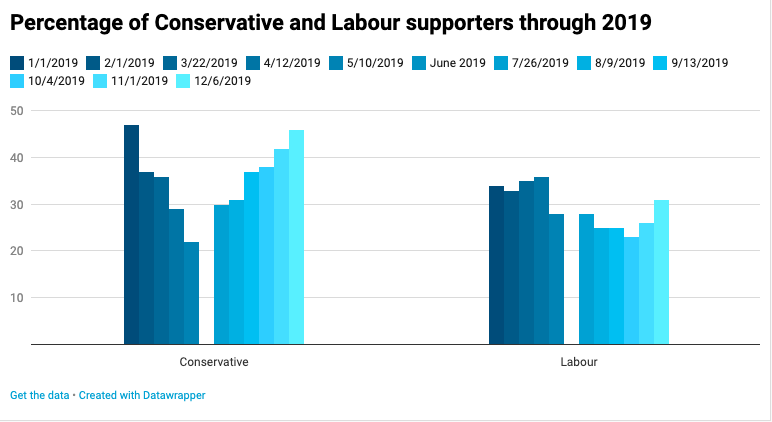

With a day left until the final vote, Labour has tightened the grip but still remain significantly behind.
The latest polls provide our first clues to how the election taking place on December 12 might unfold.
What do polls actually mean?
Opinion polls are conducted and designed to represent the opinions of a population by asking a series of political and economic related questions. These results are then extrapolated into ratio or percentages.
Voter opinion shifts from day to day, and public opinion polls capture only a snapshot of public opinion at a particular moment in time. Richard Seymour from The Guardian said, “There is something authoritative and reassuring about a round number. But we shouldn’t pretend that a percentage can meaningfully represent the views of the public.”
Statistics from Opinium Research on December 6 shows the Conservative and the Labour party are in the lead. The Conservative party at 46 per cent and Labour party at 31 per cent. Therefore, I will be comparing the likeability of both these parties.
The poll surveyed 2,002 people across different regions of the UK.
There has been a huge decrease in support for Labour between May and October of this year by four per cent. However, in the last month, the number of Labour supporters has risen by five per cent.
The data puts the Conservatives in the low to mid-40s and Labour in the low 30s, in percentage terms, across Britain as a whole.
Interestingly, Labour reached its peak with 36 per cent of supporters in April of this year, creating a five per cent gap between Labour and the Conservative Party.
A month later in May, support for the Labour Party dropped by eight per cent but Labour still remained ahead of the Conservative party by six per cent.
The support for Labour continued to drop until October of this year by four per cent. However, in the last month, the number of Labour supporters has risen again by five per cent.
No data was picked up for the month of June.
From July till December, support for the Conservative Party grew rapidly. The number of voters who said they would vote for the Conservative Party on July 26 increased from 30 to 46 per cent on December 6. This increase could mean the Labour Party is at risk of losing this election.
What the poll is looking like currently:
The most recent voting intentions released by Opinium suggest Conservative remain in the mid 40 percentage. Labour still relatively in the low 30 per cent but two per cent increase from December 6.
The Tory government haven’t had the most success since the last election – Tory seat numbers fell from 326 to 318, eight seats short of what was wanted. Theresa May’s Conservatives lost seats to Labour and Liberal Democrats in England and Wales. Halfway through Theresa May resigned and Boris Johnson took over. Many Brexit deals were declined by either party members or the EU. More recently, the Tory government have been exposed over talks about privatizing the NHS and selling it to the US from records as early as 2017. The NHS and Brexit have become a key battleground this general election.
Could Labour win this election?
The Conservative Party isn’t the only party which has had severe issues since the last election. The Labour Party leader, Jeremy Corbyn, has faced allegations of antisemitism which have resulted in a number of members leaving the party..
In July 2018, MP John Woodcock resigned from the Labour Party. A month later MP Frank field followed in his footsteps. Both cited antisemitism as a reason for quitting among other things.
More recently, Jeremy Corbyn made an appearance on This Morning where he apologised for antisemitism in the Labour party. Jeremy Corbyn said: “Obviously I’m very sorry for everything that’s happened but I want to make this clear, I am dealing with it. I have dealt with it.”
If the polls are any indication, there is a high chance of the Conservative Party winning again. However, we might still be in for a shock as supporters of the Labour Party might bridge the gap in time.

